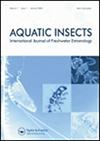Demographic characteristics of Ischnura elegans (Vander Linden, 1820) (Odonata: Coenagrionidae) in arid regions: sex and female morphs differences in survival and capture probabilities, space use patterns and spatial density
IF 0.5
4区 农林科学
Q4 ENTOMOLOGY
引用次数: 0
Abstract
Abstract We used the mark-recapture method to gather fundamental information on the population dynamics of Ischnura elegans (Vander Linden, 1820) in an arid region of central Iran. Ischnura elegans expresses female-limited colour polymorphism. We investigated sex and female morphs differences in survival and capture probabilities, space use patterns and spatial density. We used Cormack–Jolly–Seber and spatial capture-recapture models. The estimated capture probability for males was lower than females. The survival probability was not different between either males and females or gynomorphs and andromorphs. We found support for sex differences in density and detection probability, and female morphs differences in density, space use and detection probability. Based on our results the extreme conditions of arid regions can lead to a male-biased dispersal. Our findings also confirm the existence of behavioural differences between andromorph and gynomorph females and suggest a within species spatial habitat partitioning.干旱区elegans (Vander Linden, 1820) (Odonata: Coenagrionidae)的人口统计学特征:雌雄形态在生存和捕获概率、空间利用模式和空间密度方面的差异
摘要我们使用标记重捕获方法收集了伊朗中部干旱地区伊什努拉线虫(Vander Linden,1820)种群动态的基本信息。秀丽隐杆线虫表达女性有限的颜色多态性。我们调查了性别和女性形态在生存和捕获概率、空间使用模式和空间密度方面的差异。我们使用了Cormack–Jolly–Seber和空间捕获-再捕获模型。估计捕获雄性的概率低于雌性。无论是雄性和雌性,还是雌体型和雄体型,存活概率都没有差异。我们发现支持密度和检测概率的性别差异,以及女性在密度、空间使用和检测概率方面的形态差异。根据我们的研究结果,干旱地区的极端条件可能导致男性偏向的扩散。我们的研究结果还证实了雄性和雌性之间存在行为差异,并表明了物种内的空间栖息地划分。
本文章由计算机程序翻译,如有差异,请以英文原文为准。
求助全文
约1分钟内获得全文
求助全文
来源期刊

Aquatic Insects
生物-昆虫学
CiteScore
2.00
自引率
25.00%
发文量
27
审稿时长
>12 weeks
期刊介绍:
Aquatic Insects is an international journal publishing original research on the systematics, biology, and ecology of aquatic and semi-aquatic insects.
The subject of the research is aquatic and semi-aquatic insects, comprising taxa of four primary orders, the Ephemeroptera, Odonata, Plecoptera, and Trichoptera but also aquatic and semi-aquatic families of Hemiptera, Coleoptera, and Diptera, as well as specific representatives of Hymenoptera , Lepidoptera, Mecoptera, Megaloptera , and Neuroptera that occur in lotic and lentic habitats during part of their life cycle. Studies on other aquatic Hexapoda (i.e., Collembola) will be only accepted if space permits. Papers on other aquatic Arthropoda (e.g., Crustacea) will not be considered, except for those closely related to aquatic and semi-aquatic insects (e.g., water mites as insect parasites).
The topic of the research may include a wide range of biological fields. Taxonomic revisions and descriptions of individual species will be accepted especially if additional information is included on habitat preferences, species co-existing, behavior, phenology, collecting methods, etc., that are of general interest to an international readership. Descriptions based on single specimens are discouraged.
Detailed studies on morphology, physiology, behavior, and phenology of aquatic insects in all stadia of their life cycle are welcome as well as the papers with molecular and phylogenetic analyses, especially if they discuss evolutionary processes of the biological, ecological, and faunistic formation of the group.
 求助内容:
求助内容: 应助结果提醒方式:
应助结果提醒方式:


